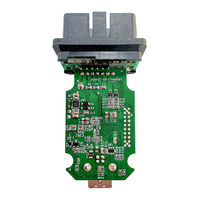ST STM32F407ZGT6J ARM Microcontroller Manuals
Manuals and User Guides for ST STM32F407ZGT6J ARM Microcontroller. We have 1 ST STM32F407ZGT6J ARM Microcontroller manual available for free PDF download: Reference Manual
ST STM32F407ZGT6J Reference Manual (1749 pages)
Brand: ST
|
Category: Computer Hardware
|
Size: 28 MB
Table of Contents
-
-
Glossary58
-
D-Bus62
-
I-Bus62
-
S-Bus62
-
Busmatrix63
-
DMA2D Bus63
-
Memory Map64
-
Table 164
-
Bit Banding68
-
Introduction73
-
Erase85
-
Programming86
-
Interrupts88
-
Option Bytes88
-
CRC Introduction113
-
CRC Registers114
-
CRC Register Map115
-
Power Supplies116
-
Low-Power Modes126
-
Sleep Mode129
-
Standby Mode136
-
PWR Register Map149
-
Power Reset150
-
Reset150
-
System Reset150
-
Clocks151
-
HSE Clock154
-
HSI Clock155
-
LSE Clock156
-
LSI Clock156
-
RTC/AWU Clock157
-
Watchdog Clock158
-
RCC Registers161
-
RCC Register Map210
-
Reset213
-
System Reset213
-
Power Reset214
-
Clocks215
-
HSE Clock217
-
HSI Clock218
-
LSE Clock219
-
LSI Clock220
-
RTC/AWU Clock221
-
Watchdog Clock221
-
RCC Registers224
-
RCC Register Map265
-
Port Pins278
-
(X = a281
-
GPIO Registers281
-
(X = a282
-
(X = a284
-
(X = a286
-
(Syscfg_Exticr1)291
-
(Syscfg_Exticr2)291
-
(Syscfg_Exticr3)292
-
(Syscfg_Exticr4)293
-
Break Feature579
-
Preloaded)701
-
(Stm32F43Xxx)720
-
Figure 262. I899
-
Figure 268. I903
-
Figure 282. I908
-
Table 159. SD Status1046
-
Table 171. Lock Card1053
-
Mode1494
-
Mode1495
Advertisement
Advertisement
